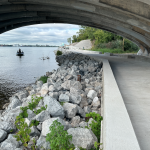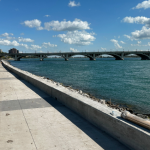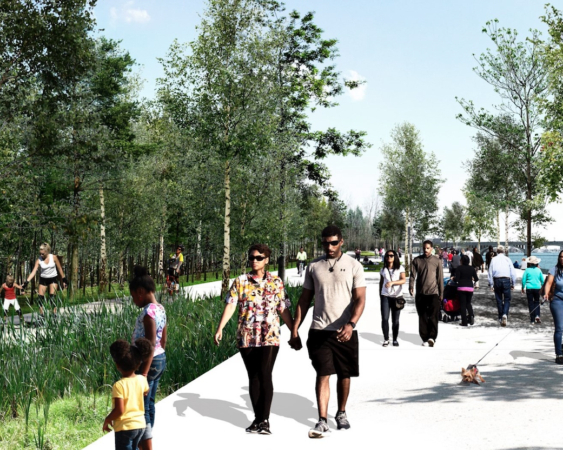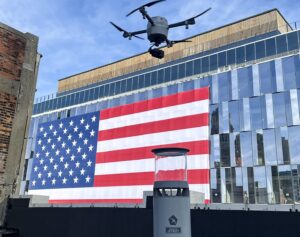A game-changer for Detroit occurred over the weekend and it’s been 20 years, millions of dollars, and a multitude of unique collaborations in the making. The Detroit Riverfront Conservancy – along with General Motors, The Kresge Foundation, and the Michigan Department of Transportation – celebrated the completion of the 3.5-mile East Riverfront with the opening of the Uniroyal Promenade.
Said William Smith, Chief Financial Officer of the Detroit Riverfront Conservancy, “This is more than just a piece of a path, it’s the completion of a bold vision that will forever change the city.”
The Uniroyal Promenade is a half-mile Riverwalk extension along the Uniroyal site between the riverfront and Jefferson Avenue. In addition to connecting Gabriel Richard Park with Mt. Elliott Park, the new section provides safe and direct access to the Belle Isle Bridge.
Detroitisit had the opportunity to speak with the Conservancy’s President and CEO, Mark Wallace who shared his thoughts and enthusiasm about this transformation for the city.
DII: What do you think the completion of the East Riverwalk means to the city?
Wallace: Looking back, when the Detroit Riverfront Conservancy began I think people had pretty low expectations. A lot of people had come to the city and promised to do big things that didn’t happen. I think the Riverwalk is one of those projects that will remind us of what we can do when philanthropy, corporations, and city leadership come together with a common mission.
I also think the impact on the city is huge. It’s important to have beautiful places and parks. Detroiters want to have places to come together in a meaningful way and we have Eastern Market and Belle Isle, and Hart Plaza, and Campus Martius … and now they are all connected.
The Riverwalk is also free. Anyone can come down on any day of the year and enjoy. And you see it play out. You see people celebrating their happiest moments like weddings and senior pictures, and also those reflecting or soul searching. All of these events can happen on any given day.
The Riverfront Conservancy and all of the parties involved have remained totally focused for twenty years to be able to offer this to Detroit.
DII: Was sustainability a factor in this project?
Wallace: Yes, in several ways.
First, there was a significant amount of cleanup required since this was an industrial area. Materials had migrated from the site into the water and we could not allow that to continue. We partnered with the Great Lakes Restoration Initiative and the EPA. We brought $1 million to the table and they brought $3 million to clean up the river.
Second, instead of building a seawall, we used different layers of stone to hold the site in place to create a safe habitat and natural areas for insects, fish, and birds. The other day I saw a heron fishing along the stone that had not been there before. It was such a beautiful thing to see and I expect that to happen over and over.
Also, when we build with more natural materials, the lifespan is much longer. We will have to do maintenance on this natural edge in time but will not have to rebuild it like you’d have to do with a seawall.
And finally, from the earliest conversations, this idea of stewardship has always been at the forefront. This is a big part of why the Conservancy exists. We promised the Riverwalk would remain clean, and beautiful, and safe at all times, and for twenty years we’ve made good on that. I’m proud of that legacy. And a huge credit goes to the Kresge Foundation which required us to build an endowment in order to access their full $50 million grant commitment. This caused us to remain focused, and now it will benefit the community for generations to come.
DII: What can people expect to see on this stretch of the Riverwalk now?
Wallace: I think it’s an amazing experience for a number of reasons. When walking from Mt. Elliot Park to Gabriel Richard Park, you will be among the first pedestrians to experience anything from this site. You can stand in a spot where so much industry has occurred which has been so important, but it’s been closed off to the public for so long.
You can also see Belle Isle from a different vantage point. The view is unobstructed.
You can walk under the MacArthur Bridge and its beautiful lines and architecture with the water lit from both sides.
And because the river is an important flyover point for birds you can see interesting wildlife.
It’s a very unique and interesting spot.
DII: What was the most challenging part of this project?
Wallace: Dealing with the site. The contaminations and the grade changes. We needed to involve several partners, but those partners along with Mayor Duggan have been focused on it for a long time and we got it done.
DII: What excites you most personally about it?
Wallace: The people. I can’t wait to see people out there interacting with a space in a way they’ve never been able to before.
As always, be sure to subscribe to our newsletter for regular updates on all things Detroit.






















